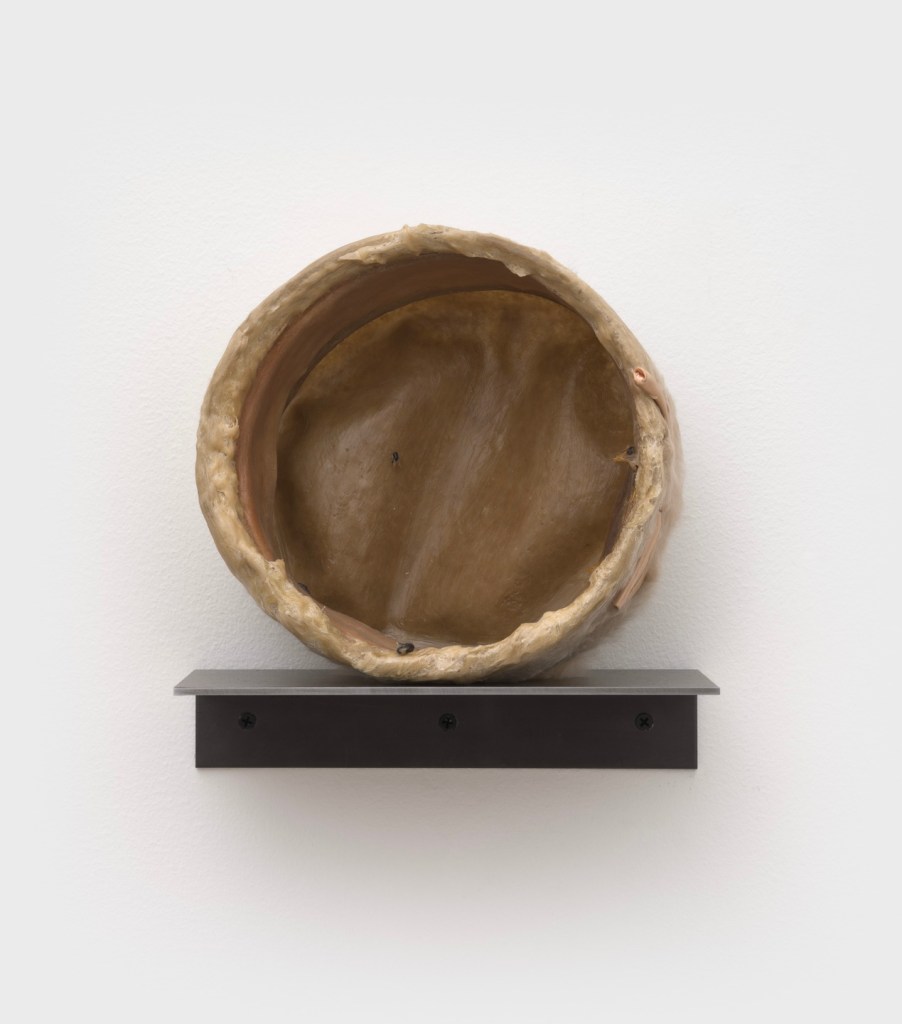
Contributed by Talia Shiroma / Pink teddy bears, plastic ponies, and the blank face of a Mac 512 computer peer out from blocks of amber murk. They are among the discarded goods on display at Nicelle Beauchene Gallery as part of Berkeley-based artist Lucy Puls’s solo show, spanning works created between 1989 and 2003. For the series In Resin, which she began in the early nineties, Puls amassed secondhand items from thrift shops and encased them in translucent resin prisms. Ranging from a BB gun to records, these once-coveted objects now register as curiously impotent, floating in their chambers like specimens in jars. Although they are up for sale once more, the encased objects feel unobtainable, as if quarantined from both time and human desire.

Puls has said that she is interested in obsolescence in consumer culture – the unsettled existence of objects that “are dismissed as outdated and/or trash” and how easily we dispose of what we no longer deem attractive or useful. In resin sculptures, she has arranged abandoned goods by type and made them beautiful again, constraining the chaos and brokenness of waste by way of orderly rectangles. Yet the tension between junk’s unruly proliferation and the artist’s Minimalist configuration of space can feel disjointed rather than illuminating. Many of the sculptures appear unresolved, never quite tethering ideas about rejection and waste to the resin’s prismatic forms, whose light effects and spatial presence hint that they are more than pretty containers.

The strongest works in the series rhyme the shapes of the goods enclosed with those of their resin enclosures. In Segmenti Octo (Proctor Silex, w/ red), the stacked silver toasters and their rectangular slots harmonize with the vertical outline of their prism. With these sculptures, Puls nods to the pleasures of mass production, incorporating qualities of precision, symmetry, and sterility into her arrangements of the cast-off objects. A stack of thermoses elegantly submerged in resin and a neatly encased computer gleam with pristine manufacture. In contrast, other resin prisms bear cracks and warps, subordinating the blocks’ geometrical purity to their flawed material, as though surfacing the violence and corrosiveness of fabrication.

Works on display from Puls’s two other series effect similar transformations of prosaic objects, with mixed results. A pair of sculptures drawn from the series Small Things, consisting of found objects embalmed in wax – here, a fur hat and a roll of paper towels with the fulsome addition of dead flies – come across as stodgy versions of the readymade. More compelling are Puls’s sculptures from Of Book, for which she has disassembled and defaced old reference texts. In Imperfectus (Encyclopedia Britannica), she has pulled apart pages from the Encyclopedia Britannica, then painstakingly glued and layered them into the whorled shape of a hay bale. The play with forms, converting one stack of pages into another, works because it is both funny and conceptually sound, representing the accumulation of knowledge in a way that makes its complete acquisition impossible, and moreover, liable to fray or roll away.



In Pollex (Webster’s New Modern) and Notae Litterarum (Foreign Trade), Puls has again turned texts into objects, this time by destroying material instead of reconfiguring it. Ghostly impressions of fingerprints and pencil marks are carved into a dictionary and a foreign trade handbook, as though materializing their repeated use. The latter book is opened to a page with instructions on how to construct alphabetic codes, which suggests Puls’s own alterations of form to generate new meanings. It’s a fittingly reflexive moment in a body of work suffused with optimism about form’s uses, and their power to freshly describe a world filled with outworn and undesired things.
“Lucy Puls: Here Everywhere – Selected Works: 1989–2003,” Nicelle Beauchene Gallery, 7 Franklin Place, New York, NY. Through May 18, 2024.
About the author: Talia Shiroma is an arts worker and writer living in Brooklyn. She contributed a chapter to the edited volume Tania El Khoury’s Live Art: Collaborative Knowledge Production (Amherst College Press, 2023) and has written for The Magazine of the Decorative Arts Trust.


















I wish the review had mentioned Puls’ 2021 debut exhibition with Beucene, where more recent work expanded the languages of the earlier work in surprising, even ephemeral ways. Seeking to articulate “a physical object that is both there and not there, devoid of any use-value yet rife with manifold meanings and associations,” as per the gallery press release, by casting objects in resin or amber for Shiroma “quarantine” the work from human connection, but the unattainability carries power.